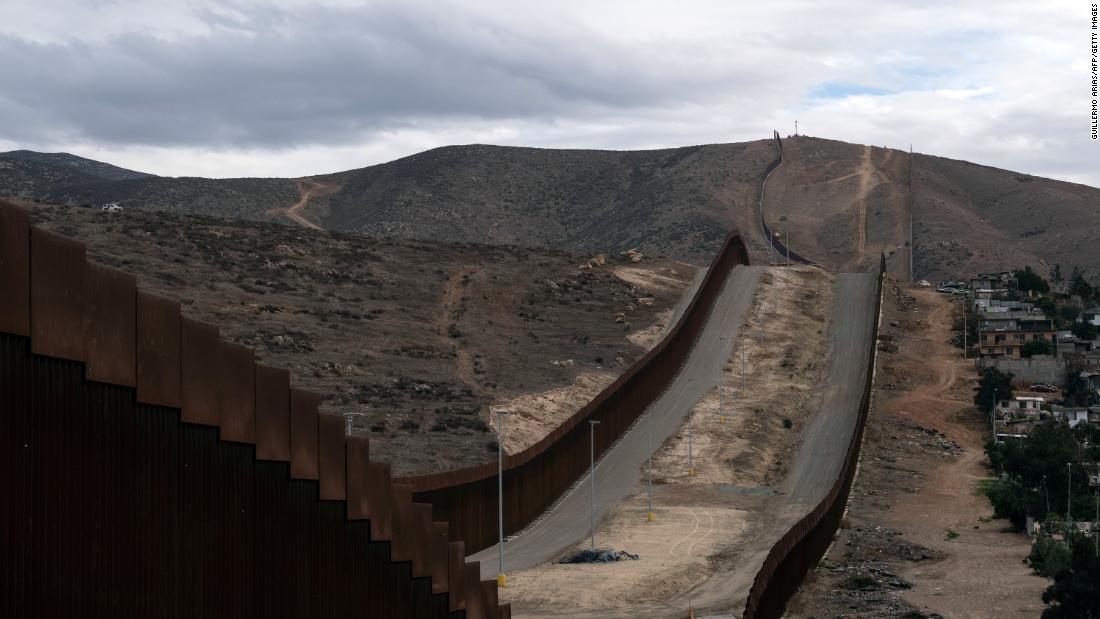[ad_1]
The hand-printed signs, in neat block letters, appeared in the Tulum marketplace the morning after two tourists were shot dead and three others wounded at a roadside eatery in the bohemian Mexican resort town.
“Attention merchants of Tulum … this was a warning,” said the sign, which went on to threaten “managers and owners” of bars and restaurants on the “Mini Quinta” tourist zone. That’s where the foreigners, visiting the Malquerida Bar last month, had the bad luck of getting caught in cartel crossfire.
The signs were photographed by a local citizens’ advocacy group, which posted them to social media. The message threatened death to merchants who refuse to fork over bribes to the drug-trafficking gangs and was signed by Los Pelones — “the bald ones.”

The gang has been a longtime enforcer of the Gulf Cartel, whose battle against their archrivals — the ferocious Jalisco New Generation Cartel and Sinaloa Cartel — has recently resulted in shocking gangland-style violence along the Riviera Maya, a sun-drenched stretch of beaches on the Yucatan Peninsula that is Mexico’s biggest tourist hub.
Things have become so dangerous that on Wednesday, Mexico’s President Andres Manuel Lopez Obrador announced the creation of a “tourist battalion” — 1,500 National Guard soldiers wielding automatic weapons to keep visitors safe.
Beginning next month, the soldiers will be stationed in Cancun and surrounding areas, including Tulum, where Mexican law enforcement said there are 10 groups fighting for drug dominance in the picture-postcard resort town.

On Oct. 21, US travel blogger Anjali Ryot, 25, and German tourist Jennifer Henzold, 35, were gunned down in the Tulum shooting. Two weeks later, dozens of tourists were forced to scramble for cover when 15 gang members, their faces hidden by ski masks, went on a daylight shooting rampage on a beach in the village of Puerto Morelos, south of Cancun, killing two suspected traffickers.
“What we’re seeing is a huge increase in street fighting from the plaza bosses,” Texas-based security consultant Robert Almonte, an expert on Mexican cartels, told The Post. “That’s how they respond when rivals come onto their turf. They don’t lose any sleep over who they shoot. And if there are innocent bystanders, too bad. That’s the way they think.”

In addition to the 10 outfits fighting to control drug sales in the “plazas” or drug marketplaces of Tulum, there are two other gangs in Cancun fighting for dominance of the Riviera Maya, according to Oscar Montes de Oca, the lead prosecutor in the state of Quintana Roo, where Cancun, Puerto Morelos and Tulum are located.
State governor Carlos Joaquin called the recent beach commando raid “a serious blow to the development and security of the state … putting the state at grave risk.” With turf wars increasing among rival cartels, homicides in the state rose from 145 in 2015 to 628 in 2020 — a 333 percent increase in a place where 75 percent of the local economy is based on tourism, according to Mexican statistics.
“Mexico is not doing anything to fix the problem,” Almonte told The Post. “My concern is that, as a tourist, you are not going to be the target, but you might be sitting at a table next to a target, and suddenly that vacation becomes your last.”

The Jalisco New Generation Cartel was founded in 2009 by Nemesio Oseguera Cervantes (“El Mencho”), who is among the most wanted drug traffickers on the planet after the 2014 arrest of Joaquin “El Chapo” Guzman, head of the Sinaloa cartel. The US Drug Enforcement Administration has listed a $10 million bounty for El Mencho’s capture.
Jalisco is among the main producers of the fentanyl and methamphetamine that is smuggled to the US. It’s also become the most feared of the Mexican drug gangs.
Cartel members last year tried to assassinate Omar Garcia Harfuch, Mexico City’s chief of police, in an attack that wounded him and left three people dead, including two of his bodyguards. In 2015, they shot down a military helicopter with a rocket-propelled grenade.

In 2015, Oseguera’s son Rubén Oseguera González, known as El Menchito, was arrested on drug-trafficking charges and last year he was extradited to the US, where he awaits trial.
And this week, the group was hit with a real blow, according to Almonte: Mexico’s military arrested Rosalinda González Valencia, the wife of Cervantes.
The woman known as “La Jefa” — the chief — was Jalisco’s main accountant, part of a subgroup known as Los Cuinis, Almonte said. Arrested in an upscale Guadalajara neighborhood on Monday, Gonzalez Valencia is charged with laundering money for the cartel.
“Who knows what kind of information she will give to authorities,” Almonte told The Post.
While it’s unclear whether the high-profile arrest will lead to the Jalisco Cartel’s retreat, the rival Gulf Cartel also faces challenges with the recent death of their leader, Ariel (“El Tigre”) Trevino Pena, who was killed by the Mexican army in a shootout in Matamoros in October.

The Gulf Cartel — among the oldest criminal enterprises in Mexico — is mired in infighting, according to security experts.
Founded by Juan Nepomuceno Guerra Cárdenas in the 1930s in Matamoros, the Gulf Cartel first smuggled alcohol across the border during Prohibition. Later, the operation expanded to include gambling, prostitution and theft. The ’80s saw Gulf focus on cocaine and marijuana trafficking, followed by fentanyl and other synthetic drugs — not to mention racketeering and human trafficking at the border, according to Mexican and US authorities.
The Gulf Cartel also has cells in some border towns in Texas, and alliances with mobsters in Italy.
And then there is the Sinaloa Cartel. With El Chapo sentenced to life imprisonment at a maximum-security prison in Colorado, the group is now run by Ismael “El Mayo” Zambada Garcia, 73.

Zambada Garcia, who headed up his own eponymous criminal operation before joining the Sinaloa Cartel alongside El Chapo, is reportedly in ill health and in hiding. In September, the State Department tripled the reward for information leading to his capture from $5 million to $15 million.
Earlier this month, the State Department announced a $5 million bounty for information leading to the arrest of four Sinaloa drug traffickers, including Aureliano Guzman Loera, who is known as “El Guano” and is the older brother of El Chapo.
With longtime kingpin El Chapo gone, things have been a bit messy in the organization, which smuggles a wide variety of drugs, including opioids. In addition to battling their enemies in the Jalisco and Gulf cartels, they are fighting among themselves for control, said Almonte.
“Right now you have factions fighting for leadership within the Sinaloa Cartel to control the sale of opioids, and you have the larger cartels all fighting each other,” he told The Post. “It’s a mess.”

All the violence comes at a time when Mexico is trying to bolster its tourism sector, which accounts for 8.5 percent of the country’s gross domestic product. In 2019, that amounted to more than $25 billion generated from 45 million tourists, according to Mexico’s National Tourism Business Council. During the height of the pandemic last year, the country’s tourism revenues plummeted by more than 50 percent.
Despite the uptick in violence at tourist destinations and the deployment of troops, Lopez Obrador said the country is forging ahead with ambitious plans to construct an international airport in Tulum by 2023, as well as a 900-mile train route that would link resort spots in Quintana Roo to some of the region’s far-flung historic and ecological sites.

“Tulum will keep growing because the Mexican government is really investing in tourism here,” said Susann Rottloff, a Tulum-based realtor and German expatriate who has lived in Tulum for the last three years. “People keep asking me if Tulum is safe. I am a single woman and I’ve never had a problem, and Tulum is packed right now.”
Despite last month’s shootings, visitors continue to flock to the resort town. More than 140,000 descend on the region every week, according to Mexican government statistics, with many wanting to invest in property for the long term, Rottloff told The Post this week.
“I feel extremely safe here,” said a Dutch expatriate, who just closed on a home in the area. The 63-year-old entrepreneur, who did not want to be identified by name, said he has been vacationing in Tulum for more than 10 years, and bought his first condo in the seaside resort town overlooking the azure waters of the Caribbean Sea two and a half years ago.
“I feel safer here than I do in Los Angeles,” he said, adding that after the October shootings, the Mexican government dispatched 450 National Guard soldiers to Tulum to keep the peace.

“I think the government took a lot of security measures after it happened,” he said, adding that authorities also cracked down on drug trafficking in the area. “For a number of months you would go to a restroom in a restaurant and there would be some guy with a backpack trying to sell you drugs. That’s all gone now. The government has gotten really serious about cracking down on crime.”
Despite the recent spate of drug violence, Tulum’s foreign residents are staying put.
“Well, we’re still doing business in real estate,” said Rottloff. “It’s [the recent violence] definitely concerning but it’s all relative. Other places in the world are far more violent.”
But for Almonte, who organizes seminars for US law enforcement on Mexican cartels, “things are out of control and the Mexican government does not have a handle on it,” he said. “I’m asked a lot about travel to Mexico, and my recommendation is don’t go.”
[ad_2]
Source link















